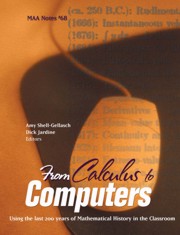Book contents
- Frontmatter
- Preface
- Contents
- Introduction
- I Algebra, Number Theory, Calculus, and Dynamical Systems
- II Geometry
- III Discrete Mathematics, Computer Science, Numerical Methods, Logic, and Statistics
- IV History of Mathematics and Pedagogy
- 16 Incorporating the Mathematical Achievements of Women and Minority Mathematicians into Classrooms
- 17 Mathematical Topics in an Undergraduate History of Science Course
- 18 Building a History of Mathematics Course from a Local Perspective
- 19 Protractors in the Classroom: An Historical Perspective
- 20 The Metric System Enters the American Classroom: 1790–1890
- 21 Some Wrinkles for a History of Mathematics Course
- 22 Teaching History of Mathematics Through Problems
- About the Authors
21 - Some Wrinkles for a History of Mathematics Course
from IV - History of Mathematics and Pedagogy
- Frontmatter
- Preface
- Contents
- Introduction
- I Algebra, Number Theory, Calculus, and Dynamical Systems
- II Geometry
- III Discrete Mathematics, Computer Science, Numerical Methods, Logic, and Statistics
- IV History of Mathematics and Pedagogy
- 16 Incorporating the Mathematical Achievements of Women and Minority Mathematicians into Classrooms
- 17 Mathematical Topics in an Undergraduate History of Science Course
- 18 Building a History of Mathematics Course from a Local Perspective
- 19 Protractors in the Classroom: An Historical Perspective
- 20 The Metric System Enters the American Classroom: 1790–1890
- 21 Some Wrinkles for a History of Mathematics Course
- 22 Teaching History of Mathematics Through Problems
- About the Authors
Summary
Introduction
In teaching an upper-division history of mathematics course using a traditional text—recently I used Howard Eves' An Introduction to the History of Mathematics, Sixth Edition, 1990—I found it helpful to incorporate several wrinkles in the course. Aside from enlivening the course they permit the inclusion of some recent history, as my examples below illustrate. This inclusion is especially useful in teaching with a traditional text such as Eves, where one is hard-pressed to get to even 18th century mathematics in a single term. I will discuss three such wrinkles, each of which involves some recent history of mathematics:
Using a handout “Some Questions to Whet your Appetitle” in class on the first day;
Starting class with an historical fact for that date;
Showing a biographical video for an outstanding modern mathematician.
Some Questions to Whet your Appetite
To start the course with gusto, I passed out in the first class meeting a list of sixteen questions, distributed as follows: Mathematical People (8), Mathematics (5), Mathematical History (3). Students worked in class on the questions individually or with their neighbors for twenty minutes or so, then we discussed possible answers at the end of class. (Students did not hand in their answers.) The complete list of (slightly-modified) questions is in the appendix. I discuss below each of the ten questions that involve some recent history, and I include some students' responses and comments, along with several observations of my own.
- Type
- Chapter
- Information
- From Calculus to ComputersUsing the Last 200 Years of Mathematics History in the Classroom, pp. 237 - 242Publisher: Mathematical Association of AmericaPrint publication year: 2005

